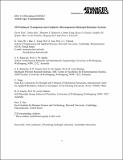| dc.contributor.author | Tian, Kevin | |
| dc.contributor.author | Bae, Jinhye | |
| dc.contributor.author | Bakarich, Shannon E. | |
| dc.contributor.author | Yang, Canhui | |
| dc.contributor.author | Gately, Reece D. | |
| dc.contributor.author | Spinks, Geoffrey M. | |
| dc.contributor.author | in het Panhuis, Marc | |
| dc.contributor.author | Suo, Zhigang | |
| dc.contributor.author | Vlassak, Joost J. | |
| dc.date.accessioned | 2017-01-17T20:11:09Z | |
| dc.date.issued | 2017 | |
| dc.identifier | Quick submit: 2016-12-14T08:58:03-0500 | |
| dc.identifier.citation | Tian, Kevin, Jinhye Bae, Shannon E. Bakarich, Canhui Yang, Reece D. Gately, Geoffrey M. Spinks, Marc in het Panhuis, Zhigang Suo, and Joost J. Vlassak. 2017. “3D Printing of Transparent and Conductive Heterogeneous Hydrogel-Elastomer Systems.” Advanced Materials (January): 1604827. Portico. doi:10.1002/adma.201604827. | en_US |
| dc.identifier.issn | 0935-9648 | en_US |
| dc.identifier.uri | http://nrs.harvard.edu/urn-3:HUL.InstRepos:29995326 | |
| dc.description.abstract | Hydrogel-based ionic devices represent an alternative approach to stretchable electronics through use of soft ionic conductors that are both highly stretchable and transparent. However, these devices require the integration of dissimilar materials, dielectric elastomers and hydrogels, into a single system; a process thus far achieved primarily via the combination of several different manufacturing techniques. We have developed a 3D extrusion printing technique capable of fabricating an entire ionic circuit that integrates a LiCl-doped poly(acrylamide) (PAAm) hydrogel with a poly(dimethylsiloxane) (PDMS) dielectric elastomer. By incorporating hygroscopic salts such as LiCl into the hydrogel, we are able to prepare an ionically conductive hydrogel with excellent water-retaining properties. For printing reliability, we have optimized the rheological properties of a high ionic-strength hydrogel precursor and the interfacial energy between PDMS and hydrogel. Printed ionic devices that consist of PAAm and PDMS exhibit outstanding mechanical and electrical stability when tested with up to 1000 cycles of uniaxial tension. Moreover, we successfully demonstrate functionality in terms of signal transmission and as a soft sensor by fabricating and characterizing an ionic cable and several strain gauges. | en_US |
| dc.description.sponsorship | Engineering and Applied Sciences | en_US |
| dc.language.iso | en_US | en_US |
| dc.publisher | Wiley-Blackwell | en_US |
| dc.relation.isversionof | doi:10.1002/adma.201604827 | en_US |
| dash.license | OAP | |
| dc.subject | ionic conductor | en_US |
| dc.subject | 3D printing | en_US |
| dc.subject | hydrogel | en_US |
| dc.subject | elastomer | en_US |
| dc.subject | stretchable electronics | en_US |
| dc.title | 3D Printing of Transparent and Conductive Heterogeneous Hydrogel-Elastomer Systems | en_US |
| dc.type | Journal Article | en_US |
| dc.date.updated | 2016-12-14T13:58:08Z | |
| dc.description.version | Accepted Manuscript | en_US |
| dc.relation.journal | Advanced Materials | en_US |
| dash.depositing.author | Vlassak, Joost J. | |
| dc.date.available | 2016 | |
| dc.date.available | 2017-01-17T20:11:09Z | |
| dc.identifier.doi | 10.1002/adma.201604827 | * |
| dash.contributor.affiliated | Tian, Kevin | |
| dash.contributor.affiliated | Bae, Jinhye | |
| dash.contributor.affiliated | Suo, Zhigang | |
| dash.contributor.affiliated | Yang, Canhui | |
| dash.contributor.affiliated | Vlassak, Joost | |
| dc.identifier.orcid | 0000-0002-4068-4844 | |


